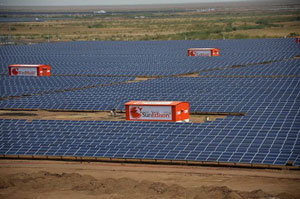 India Announces World's Largest Solar Plant By Far
Oct 10, 2013 - SustainableBusiness.com News Below we say that India's auction on 750 MW of solar has been delayed. The government is now calling for bids (due Nov. 29) in the first national auction since 2011. Lowest bidders win and will receive as much as 30% of project costs from government grants. Included is a controversial requirement for local content for half of the 750 MW. Opponents say that will raise the cost and lower the quality of projects because of India's very young solar industry. India's government made a stunning announcement - it plans to build the world's largest solar plant that dwarfs anything constructed so far. A 4 gigawatt (GW) solar plant spread over 23,000 acres in Rajasthan (which borders Pakistan) would be four times bigger than the 10 largest US plants combined. For comparison, the biggest project in the world is under construction - the 579 MW Antelope Valley plant in California. "Being the first project of this scale anywhere in the world this project is expected to set a trend for large scale solar power development in the world," says India's government.
The first gigawatt would come online in 2016 and other phases would be implemented based on that success. Skeptics question whether a plant of this size can be completed in just three years. Building such a massive solar project is intended to help bring solar prices in line with coal, but because the government requires more expensive "low carbon" forms of coal, even India's biggest coal company is turning to solar. Solar is already competitive with diesel and is expected to achieve parity with coal between 2016-2018. Funding could come from India's recently approved Corporate Responsibility law, which requires all large companies to kick in 2% of annual net profits for socially responsible projects. Under India's National Solar Mission, the target is 1.7 GW of solar by early 2014, and 20 GW by 2022 - 10% of the country's electricity. For renewable energy, the target is 80 GW by 2020. 1.839 GW of solar have been added under the first phase of the National Solar Mission and the average price per watt is down 51% since 2010. Read our article, What's Happening in India? Meanwhile, Indian state-owned utility, National Thermal Power Corporation, is in a joint venture with a Bangladesh-owned utility to build the world's largest coal plant - 1320 MW. "The Sundarbans may be one of the most inappropriate places in the world to build a polluting coal-fired power plant," says Sharon Khan, International Director of Waterkeeper Alliance. "It would be like building one on top of Old Faithful in Yellowstone National Park in the US or at the foot of Uluru in Australia." |
Email this page to a friend


